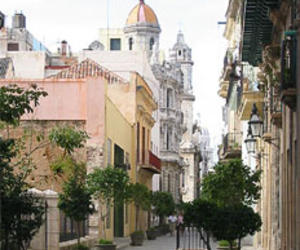Santa Monica Conservancy Shines Spotlight on Havana
- Submitted by: manso
- Society
- 07 / 28 / 2011

By Melonie Magruder. Lookout Staff. July 27, 2011 – Santa Monica may learn a lesson or two from Havana, Cuba when it comes to preserving its architectural heritage.
At least, that seemed to be the thinking behind the Santa Monica Conservancy's sponsorship of an illustrated lecture, “Preserving Old Havana: Conservation and Tourism in Today's Cuba,” presented at the main library Sunday by Dr. Ken Breisch, director of USC’s Historic Preservation Program and Emeritus board member of the conservancy.
San Cristóbal de la Habana was founded in 1515 and served as a way station for the Spanish conquest of the New World, long before American colonies like Jamestown, Virginia were even contemplated.
Breisch narrated a story of early conquest and remarkably astute urban planning in the island capitol, in an era when the sovereigns of Spain, Ferdinand and Isabella, were chasing Muslim armies from the Iberian Peninsula and funding world exploration through the likes of Christopher Columbus.
“Most activity, commercial and governmental, revolved around four main plazas in Old Havana,” Breisch said. “City planners had strict rules when creating settlements, requiring certain amounts of space for a church, streets laid out in grids, and commercial plazas for marketplaces. The city still functions much the same way.”
Breisch was able, following much bureaucratic navigation, to visit Cuba two years ago, where he found a world largely frozen in the early 1960's.
Castro’s revolution brought promises of social improvement, but his reliance on a strong communist model ensured a prompt U.S embargo and, thereafter, a slow decay of city infrastructure and practically nonexistent new urban investment.
What was left included 17th century convents, 18th century cathedrals built by Jesuits after they were kicked out of Spain, 19th century palaces built for Cuba's sugar barons, and 20th century “grand projects” conceived by European architects brought in to institutionalize their ideals of sophistication.
The Gran Teatro de Habana was designed by Belgian architect Paul Belau in 1908, and the Paseo del Prado was conceived by French landscape architect Jean-Claude N. Forestier in 1929.
Under the dictator Gerardo Machado, splendid architectural monuments were undertaken, like the Capitolio Nacional, which bears more than a passing resemblance to the U.S. Capitol building in Washington, D.C.
“Wealth just exploded with the sugar industry between the end of the 19th century and the mid-20th century,” Breisch said. “You can see the extravagance in some of the mansions built then.”
The growing wealth attracted American gangsters like Meyer Lansky, and soon the Malecón, the broad esplanade along the harbor, was lined with casinos and luxury resorts. But the explosion of wealth also widened the gap between rich and poor, leaving the country ripe for revolution.
Castro’s new government was long on rhetoric and experiments with “mixed-use” socialist housing, but short on cash; and much of Havana’s earlier glory began to fall into disrepair. The bright colors of downtown apartment buildings faded and the Rococo balconies were chipping away. The only automobiles left were late 50's, gas-guzzling, American muscle sedans.
With the collapse of the Soviet Union, Cuba fell into severe economic crisis. With no money for maintenance, historically significant buildings entirely crumbled. Families crowded into tenement-like conditions and the photos Breisch displayed showed a curious mix of grand vision and ancient decrepitude.
“But the 90's brought a rise in tourism again and renewed interest from the outside world,” Breisch said.
UNESCO named Havana’s old city a World Historical Site and launched international campaigns to safeguard the 400-year-old Plaza Vieja and other monuments. The National Center for Conservation, Restoration and Museology was founded to train young Cubans in building and arts restoration techniques.
Funding from UNESCO went directly into local economies (rather than being distributed through the government). Carved wooden balconies are being renovated, stained glass windows are being re-leaded, and 18th century treasures, like the Hotel Santa Isabel, have been restored to former glory.
“Training conservators is what will save old Havana,” Breisch said. “The city historian’s office currently has on staff 100 architects and engineers, 20 archeologists and 40 historians working on a master plan for the city.”
But endeavors tied to tourism agencies need to reconcile their capitalist progress and consumer economy with the needs of local residents, he warned.
“There is a danger of gentrification,” Breisch said, posting images of international fashion chains, like Benetton, moving into the old city. “All these western-style businesses are lining up like vultures, waiting to swoop in when Castro dies.
“It’s sort of a warning for the future of Santa Monica. If you pin everything on upscale tourism, the heart of your city is pushed out. It begs for a strong city plan.”
Source: www.surfsantamonica.com/ssm_site/the_lookout/news/News-2011/July_2011/07...
Comments